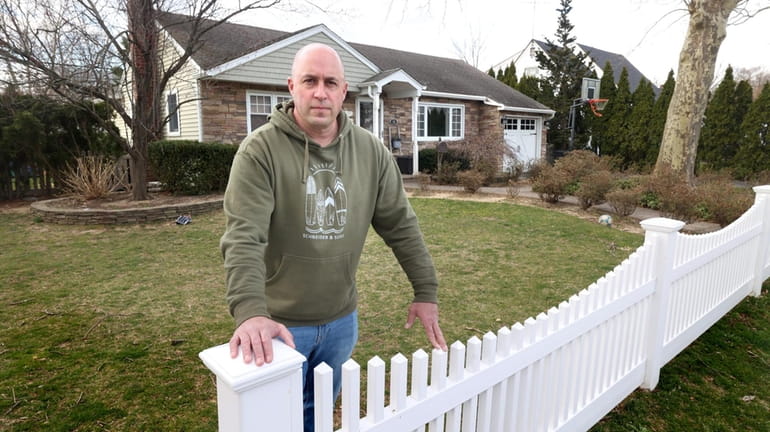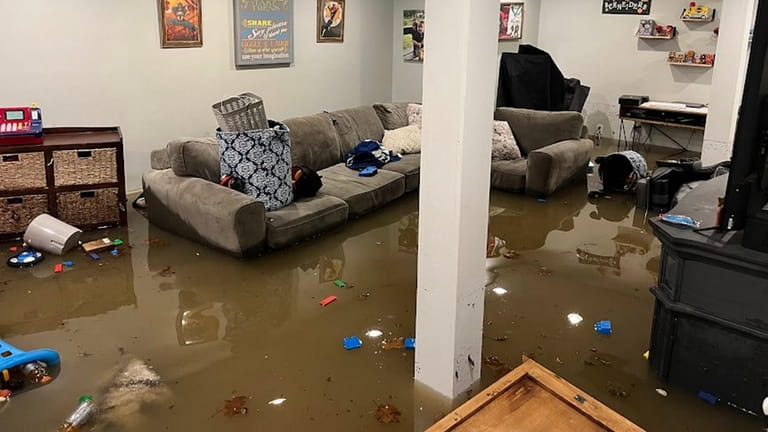New York home sellers must make disclosures under updated law in shift away from 'buyer beware'

For the past 22 years, Long Islanders selling their homes could avoid answering detailed questions about their property by giving a $500 credit to buyers.
They no longer have that option starting Wednesday, when new changes to state law take effect.
Last year, the State Legislature amended the Property Condition Disclosure Act, removing the option to give a $500 credit to buyers and adding seven questions related to a home’s flood history and insurance requirements.
The law’s backers said the changes are needed to make homebuyers aware of flood risks and prevent sellers from skirting disclosures. Local real estate agents and attorneys said waiving the seller’s requirement to fill out the Property Condition Disclosure Statement has been commonplace on Long Island since an earlier version of the law was enacted in 2002.
As a result, sellers are now responsible for answering 56 questions on topics ranging from their home’s history of fire and flood damage to any defects in electrical, heating or plumbing systems. Previously, homebuyers were responsible for discovering any issues through a home inspection under the doctrine of “caveat emptor,” or “let the buyer beware.” Sellers merely couldn’t actively conceal defects.
“There was no duty to disclose anything,” said Jeff Morgenstern, an attorney in Carle Place, who wrote about the changes for Nassau Lawyer, the journal of the Nassau County Bar Association. “The purpose of this particular law is to change that and say, now by law, you do have a duty to disclose.”
Changes to the disclosure law, signed by Gov. Kathy Hochul in September, significantly increase sellers’ responsibilities, local attorneys said.
Morgenstern said he thinks attorneys and agents will tell homeowners that they must find the answers to reduce their own exposure to lawsuits.
“This form, in a lot of ways, could become like a stick of dynamite that a lot of people will kind of steer away from and not want to touch,” he said.
The changes come at the start of a typically busy spring season for real estate, when homeowners tend to put their homes on the market as the weather warms up. The real estate industry is also still reeling from a recent settlement that could reshape how real estate agents get paid commissions later this year.
Brian Sahn, co-head of the real estate practice group at Uniondale law firm Forchelli Deegan Terrana, said he expects “a bit of chaos will ensue” as attorneys navigate the new requirements.
“This is now flipping the scales against the seller,” Sahn said.
But in today’s market, with the number of houses on the market near a multi-decade low, buyers still may not be able to negotiate a lower price.
“I don’t know if it’s going to help buyers who are out hungry to snatch up a house before the next buyer comes down the road,” Sahn said.
New questions
The updated disclosure form adds seven questions focused on whether the home is in a flood hazard area, required to maintain flood insurance, has flood insurance, received federal assistance for flood damage, has a FEMA elevation certificate or has filed a claim for flood damage with any insurer.
While only seven of the 56 questions are new, even the existing ones, which cover environmental issues, such as asbestos; structural defects, such as fire damage; and mechanical systems could confound sellers and their attorneys because skipping the form and giving the $500 buyer credit was standard practice.
“I’ve been doing this 21 years, and I’ve never had a seller fill out the property condition disclosure,” said Jared Garcia, an associate broker at Weichert Realtors in Farmingdale. “It’s almost as if this is a new law altogether.”
Sellers must answer “yes,” “no,” “unknown” or “NA,” for not applicable, to the questions. Omissions and inaccuracies could create liability for sellers.
Leah Tozer, an associate broker at Daniel Gale Sotheby’s International Realty in Long Beach, said she plans to refer clients to their attorneys for guidance. But she will share info about how to navigate the FEMA website to find answers.
“Our job is to let them know that you have to fill this out, and if they have any additional questions, they can speak to their attorney,” she said. “… I do fear sellers are going to get very overwhelmed with this.”
She said she’s happy buyers will have this information. “It’s keeping everybody honest,” she said. “There’s nothing wrong with it, and if you’re going to do the right thing, what are you worried about?”
Making the grade
The changes to the disclosure law passed last fall with the goal of bringing New York’s law in line with other states’ requirements around communicating flood risk, State Sen. Brad Hoylman-Sigal, a Democrat who represents Manhattan’s West Side, wrote in his memo sponsoring the bill.
Disclosures are needed to let buyers know they’re purchasing in a flood-prone area, according to Joel Scata, a senior attorney at the National Resources Defense Council, which supported the changes to New York’s law.
“New York homebuyers deserve to know whether their potential dream home is actually a nightmare due to flooding,” Scata said, “because flooding can be extremely costly.”
New York homes that had previous flood damage would be expected to incur $3,126 in annual damage on average over a 30-year mortgage under existing climate conditions, compared with $93 for homes without previous flood damage. That’s according to a 2022 analysis by actuarial firm Milliman, which was commissioned by the NRDC. Of course, major storms don’t hit every year, but when flooding does occur, recovery is expensive.
The environmental advocacy group had previously given New York an “F” grade for its flood risk disclosure laws but has since upgraded the state to an “A.” It is one of seven states, including New Jersey, Texas and Louisiana, to receive the top grade.
One scenario that could cost homebuyers in states that lack disclosures is if a homeowner isn’t in an area where flood insurance is required, but the previous owner accepted federal aid to rebuild after a storm. If the new owners don’t buy flood insurance, they will be ineligible to receive federal aid because of flood damage, Scata said.
“Flood maps only tell part of the picture,” he said.
'If I had known ... '
If Ryan Schneider had known about the damage flooding would cause his Farmingdale home, he doesn’t think he would have gone through with the purchase in 2017.
Schneider, 43, said he doesn’t remember ever hearing about the disclosure form — or the $500 buyer credit — back then. “We were never told anything,” he said.
During a major storm Sept. 29, water flooded Schneider’s Linwood Avenue home, causing serious damage to the basement bedroom of his two sons. The flood caused an estimated $90,000 in damage and Schneider, his wife and five children had to stay with family for 10 weeks while it was repaired.

Ryan Schneider's basement after a September flood. He says he would not have bought the home had he known about the flooding. Credit: Schneider family
“I love my block. I love the neighbors. My kids are happy there, but unfortunately, if I had known how Linwood Avenue really was with the water, I wouldn’t have bought the home,” he said.
Schneider and his Linwood Avenue neighbors are seeking reimbursement from Nassau County, the Town of Oyster Bay and Farmingdale village for the damage caused by the flooding. He said overgrown storm basins and clogged drains are to blame.
While Schneider has no plans to move, when the time comes to sell, he said he will be upfront with interested buyers.
“I wouldn’t want any new buyer to go through what we went through with this,” he said. “I wouldn’t wish that upon anybody.”
The threat of lawsuits
Local agents and attorneys said they’re still unclear how the courts might enforce the law. While sellers can no longer offer the $500 credit, attorneys questioned whether a seller could negotiate a waiver of the disclosure requirement with the buyer.
Sellers could refuse to fill out the form and take a chance that buyers won’t sue. And there’s an open question of whether a buyer could still choose to waive their right to the form, in the way many buyers have waived their ability to negotiate the price of a home after an appraisal or inspection in recent years. It could be months or years before the courts provide an answer.
Buyers have a legal right to these disclosures that doesn’t exist for other contract terms that are subject to negotiation, said Irwin Izen, an attorney in Commack who delivered a presentation on the law to the Suffolk County Bar Association.
“I’m not so sure this is something that could be waived,” said Izen, who specializes in transactional law.
Izen said the added complications for attorneys could lead them to charge higher prices. Closings could also be delayed because of the new requirements.
Attorneys have speculated that the law could lead to more post-closing lawsuits, with plaintiffs using the disclosure forms to prove a seller failed to note property defects.
“Litigation after closing, which is very uncommon, will now be much more potentially on the table,” Izen said.
Izen questioned whether the removal of the $500 credit option was necessary to improve flood information, which buyers can retrieve through public records.
“It’s going to create after-closing headaches that might be tremendous,” Izen said.

Licensed home inspector Frank Cavarra examines the heating system at a home in Babylon. Some sellers may get inspections to help them fill out the disclosure form Credit: Newsday/John Paraskevas
A boost for inspectors?
The change could make some homeowners more likely to pay for their own inspections to help fill out the disclosure form.
That could provide new business for home inspectors. Inspectors could provide answers to questions on the form related to defects in the home’s structural or plumbing systems, for example, said Matt Kaplan, owner of HouseMaster Home Inspections in Commack.
However, questions about a property’s history of water or fire damage, if it is not apparent, will still fall to homeowners to report.
“Some sellers will have a lot of difficulty filling this thing out,” Kaplan said. “They have to really think back and take their time.”
New construction, condos, co-ops, foreclosed properties and those transferred through a court order, such as estate sales, are among properties exempt from providing the disclosure form.
Kaplan said it has been rare that sellers have paid for inspections but he has started to get inquiries from real estate agents on behalf of their sellers.
Now that sellers don’t need to provide a $500 credit to buyers, they could use that money toward help with the disclosure form. Local inspectors generally charge $550 to $850, Kaplan estimated.
“A lot of homeowners didn’t want to spend the money,” Kaplan said. “Now, they may be forced to.”
— with Joseph Ostapiuk

